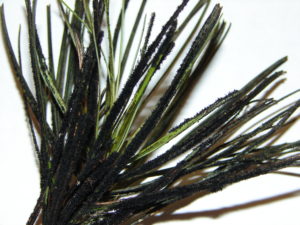By Linda Williams, forest health specialist, Woodruff, Linda.Williams@wisconsin.gov, 920-360-0665
Pine tortoise scales are sometimes found at very heavy densities on jack and scotch pine twigs. In Wisconsin they prefer young jack pine trees, inserting their straw-like mouthparts into twigs and sucking out the sap. When populations are high, pine tortoise scale can cause branch mortality and even whole tree decline.

Pine tortoise scales are so plentiful on this twig that they are practically on top of one another.
As pine tortoise scales feed, they secrete a sticky honeydew that attracts bees, wasps and ants. This honeydew also promotes the growth of black sooty mold, which can build up to the point that the tree looks dark from a distance. Needles that are covered in sooty mold are unable to appropriately photosynthesize. This can cause the branch, or even the whole tree, to decline.

Sooty mold can grow on any tree where scales or aphids are feeding and producing honeydew. Thick layers of sooty mold can block the sun and prevent needles from photosynthesizing.
Immature female scales overwinter on twigs as brown wrinkly lumps on the twigs and complete their development in the spring when they produce a huge number of eggs (up to 500!) that they lay under the mature scale’s shell. The eggs hatch in June or July, and the crawlers disperse to new spots on the tree’s twigs. Once they insert their mouthparts, the crawlers don’t move again for the remainder of their life cycles. The males that emerge from the eggs will mate with the immature female scales and the males will then die, leaving only the immature females to overwinter on the twigs.
There have been issues with pine tortoise scale periodically noted in the historical DNR Forest Health Annual Reports. Occasionally areas with high populations were treated to control the tortoise scale, but numbers were often brought under control by natural enemies, including a type of ladybug that feeds on them. Maintaining full stand stocking is also recommended to reduce problems associated with pine tortoise scale. Insecticides can be used on single trees when the crawler stage is present, but chemical treatments are not practical in a forest setting.
